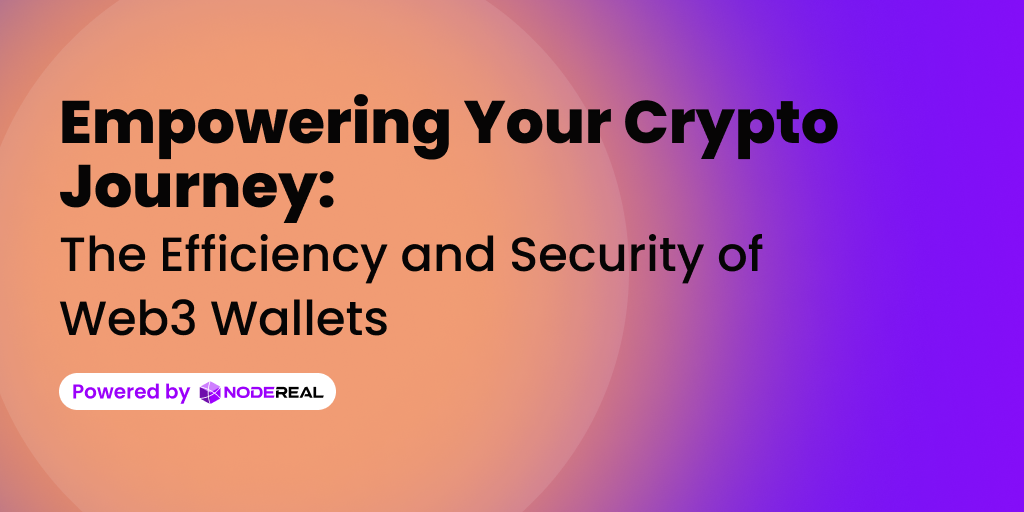I. Introduction
Web3 wallets are typically classified into two categories: cold wallets and hot wallets. A hot wallet is typically connected to the internet and used for activities such as trading on exchange platforms. On the other hand, a cold wallet is disconnected from the internet and is often referred to as a hardware wallet. It is important to note that Web3 wallets serve as a crucial gateway for extending value activities from the Web3 protocol layer to the application layer. They are specifically designed to manage and interact with cryptocurrencies and other decentralized applications (dApps).
In essential, Web3 Wallets store two keys, instead of storing any assets:
- A public key, with a wallet address, that lets you send and receive transactions.
- A private key and seed phrase that proves that you own the tokens from your address.
Web3 wallets are no longer just tools for managing cryptocurrency transactions and checking balances. Instead, the wallet stack is becoming more modular and customizable, with advanced features that cater to the needs of both users and developers.
Some significant areas of development in Web3 wallets were highlighted at the inaugural WalletCon including:
- Security
- Decentralized Identity/credentials
- Communications/Messages
- Cross-chain tech
- UI/UX experience
- Key Management/Account Abstraction/Authentication
- RPC/Node Service/API/SDK
Overall, the evolution of Web3 wallets is driving the entire industry forward. In this blog, we will cover:
- The current state of Web3 wallets
- Challenges and opportunities on Web3 Wallets
- How NodeReal supercharge the Wallet customers
As one of the leading infrastructure providers in the blockchain industry, NodeReal is dedicated to delivering top-notch services that enable the growth and adoption of Web3 technologies. Top wallets like TrustWallet, MathWallet, SafePal, and Safe have already chosen us as their key infra provider. We understand the critical role that Web3 wallets play in the ecosystem, and we are committed to providing the most reliable, scalable, and fastest services to our esteemed wallet partners.
II. Web3 Wallets Landscape
There is definitely a wide range of different wallets on the market. We will discuss in-depth the 4 types of wallets in Web3 below.
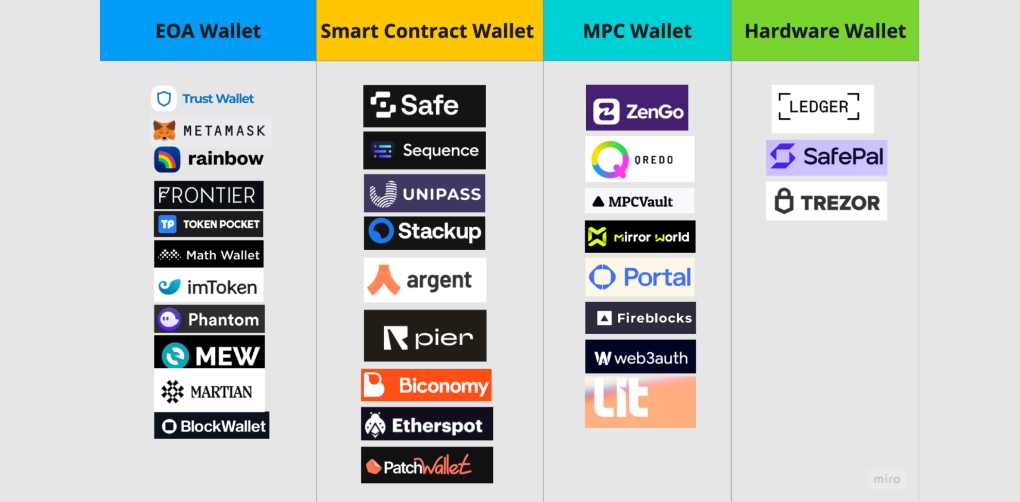
EOA Wallet
Externally Owned Accounts (EOAs) wallets, the first type of web3 wallet, utilize a seed phrase and hierarchical deterministic (HD) structure to derive private keys, corresponding public keys, and on-chain addresses. With these wallets, users can generate private keys for signing transactions and recover all keys using the seed phrase. EOA wallets like Metamask, TrustWallet, and Rainbow still dominate the Web3 wallet industry with millions of end users. While the industry is evolving, the mass adoption of Web3 is around the corner, we have to remove the single-point failure lay on conventional wallets, i.e., remembering the seed phrases and keys.
MPC (Multi-Party Computation) and smart contract wallets play a vital role in eliminating single-point failures and enhancing user experience within the ecosystem. Several services and product suites have already been adopted by end-users and institutions, and we'll delve into them further in the following section.
Smart Contract Wallet
As discussed above, most conventional web3 wallets are Externally Owned Accounts (EOAs) controlled by private keys. However, smart contract wallets are built on top of smart contracts, which enable additional security functionalities that EOAs do not have, thanks to a concept called account abstraction (AA). If a wallet is controlled by a smart contract, then it is programmed by that smart contract's code, allowing for features such as:
- Social recovery
- Transfer limits
- Account freezing for added usability and security
- Multi-sig
- Multi-auth
- White label
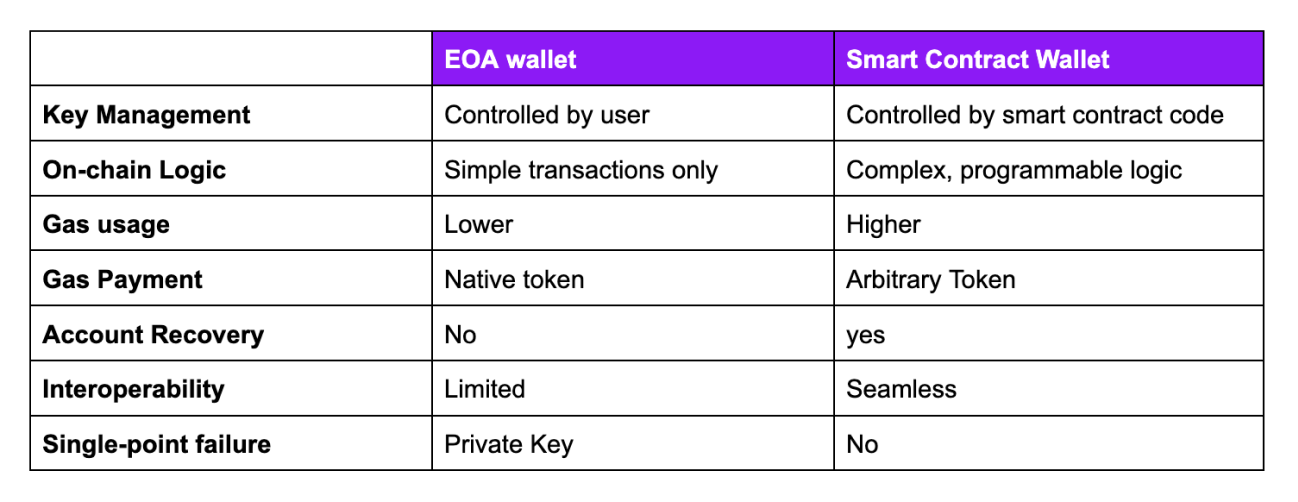
MPC wallet
MPC wallet is a cryptographic technique that divides a private key into multiple shares, with each share distributed among different parties. This technique ensures that the private key shares are never exposed, and the parties cannot access each other's shares. MPC wallets provide a self-custodial option for wallet owners without the risk of losing a single private key or seed phrase. Examples of MPC wallets include ZenGo, Fireblocks, Portal, MPCvault, Lit Protocol, and Bizzllet.
Some significant use cases for MPC wallets include:
- Team wallet management for projects
- Escrow services
- Multi-user wallets for investment
- Secure key management for exchanges and custodial services
- Voting systems
Additionally, the pros and cons of the MPC wallet can be summarised below:
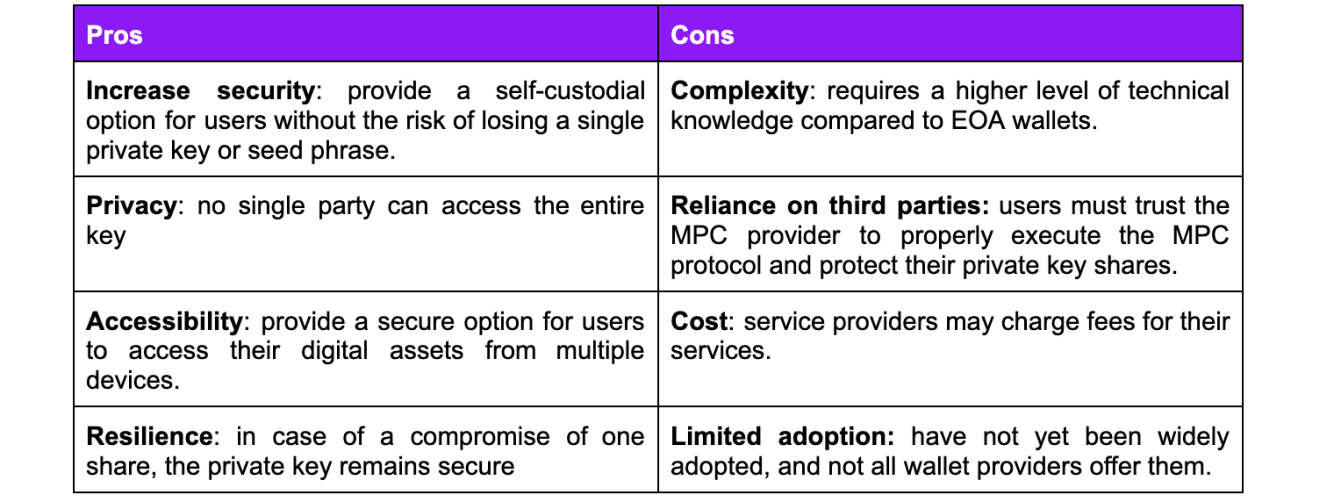
Hardware wallet
A hardware wallet is an integral component of a cold wallet system, typically comprising a physical device like a USB stick or a specialized hardware device. This type of wallet is designed to store private keys offline, thereby ensuring a high level of security and protection against potential online threats.
III. Challenges and innovative solutions on Wallets
Challenges
Before discussing the challenges and potential solutions of Web3 wallets, let's review the onboarding process of wallets:
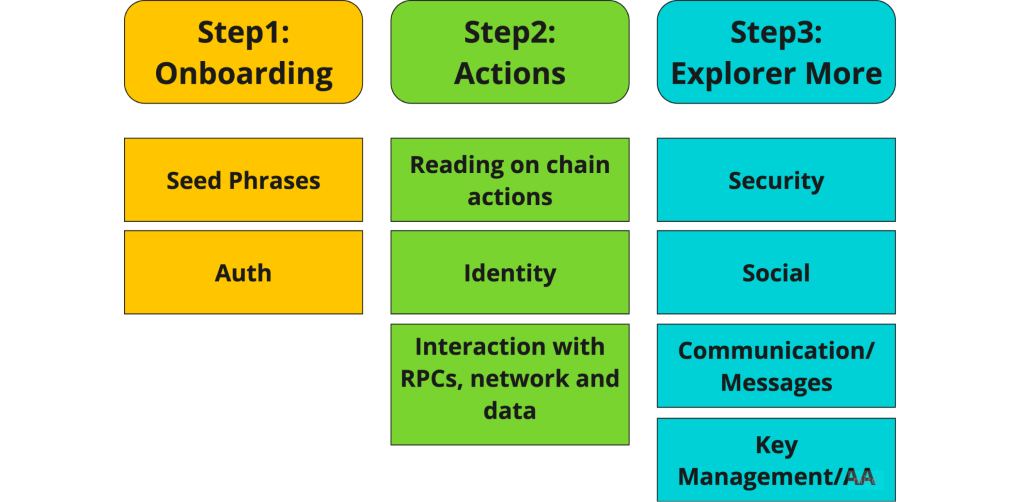
Onboarding users to the Web3 wallet application faces several critical challenges. Thus, they need to be addressed so as to simplify and make the onboarding journey more user-friendly.
These challenges include:
- Passwords and seed phrases: At the beginning of the onboarding process, users are required to save and back up their passwords and seed phrases, which can be a challenging and confusing process.
- Network Interaction: Interacting with networks and reading and writing on-chain requires high-performance infrastructure, including RPC service and data indexing. Improving the efficiency and reliability of these systems is crucial for the success of Web3 wallets.
- Security: Security is a major concern when it comes to Web3 wallets, and protecting user funds should be a top priority. Robust security measures, such as two-factor authentication and biometric verification, must be implemented to reduce the risk of hacks and theft.
- Communication and Messaging: Communication and sharing messages is a significant challenge for Web3 wallets. Implementing effective and secure messaging solutions can help improve communication and collaboration between users and wallet providers.
- Key Management: Key management is a basic but important part of using Web3 wallets. Users must be able to easily manage their private keys and be informed about the risks associated with losing or sharing them.
By addressing these challenges and improving the onboarding experience, we can help ensure that Web3 wallets are accessible and user-friendly for everyone. With the right infrastructure, security measures, and communication tools, Web3 wallets have the potential to revolutionize the way we store and manage our digital assets.
Opportunities
As we have already discussed the challenges involved in Web3 wallets (also addressed during WalletCon), let's now explore some of the exciting opportunities that this technology presents:
Security: Security always goes first in Web3, and key management has a very high priority. As for today, we have multiple solutions to solve the security challenges:
- Hardware wallet
- Paper wallet
- Multi-Party Computation(MPC)
- Multi-sig
- Social recovery
Vitalik also addressed the multi-sig and social recovery in reddit. He mentioned that multi-sig wallets (eg. Safe, MSafe) are an easy and safe way to store funds, and can give you most of the key benefits of self-custody. A social recovery wallet is a cousin of multi-sig wallets, where a single key can be used to sign transactions but if that key is lost, a group of keys held by other people can be used to recover the funds. Social recovery wallets are much easier than multi-sig wallets to use, especially with the rise of ERC-4337 account abstraction and upcoming wallets like Soul Wallet, and Argent that will make the technology user-friendly. Both multi-sig wallets and social recovery wallets rely on the concept of “guardians”.
Communications: The messaging component remains a challenging topic on WalletCon, with no clear solution yet. Some protocols, such as WalletConnect, XMTP, Push, and Notifi, are making significant progress in developing tools and solutions to improve communication and enhance user experience.
Network Interaction: To ensure seamless and efficient interactions with blockchain networks, it is crucial to have access to high-performance and scalable infrastructure. NodeReal is a platform that provides precisely that - a high-performance and seamless RPC (Remote Procedure Call) service to users.
With NodeReal, users can access fast and reliable RPC endpoints for most EVM-compatible chains, allowing them to easily interact with these networks and execute transactions quickly and efficiently.
Key Management and Account Abstraction(AA): AA is another innovative topic in Web3 Wallet, ERC-4337 is live now. In addition to the emergence of smart contract wallets, some powerful infrastructures such as Stackup, ZeroDev, Biconomy, EtherSpot, and Safe are paving the way for mass adoption. Biconomy has recently integrated AA on the mainnet, it’s quite a game-changer. If we want to explore more opportunities for AA, the following AA process can make it easier, the essential design is to introduce a new concept of user operation(UO). We can see the future of AA utilization in Web3, especially in account management.
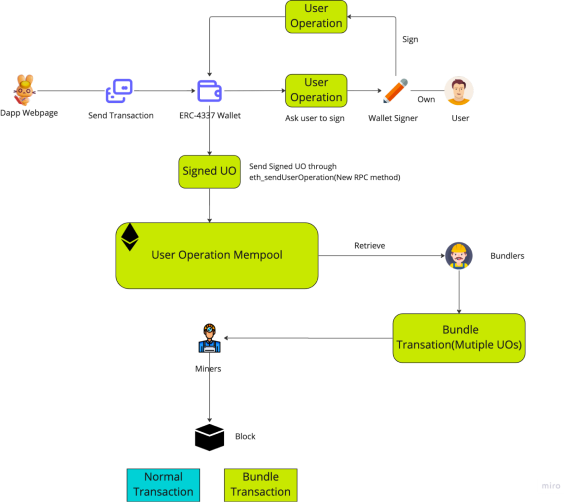
IV. Choosing a NodeReal-Powered Web3 Wallet for Your Crypto Journey
Reliable and scalable RPC service is critical to ensure the stability of Web3 wallets, and NodeReal as one of the most reliable infrastructure providers has powered multiple top-ranking wallets in different ecosystems.
- Trust Wallet: is a leading crypto wallet, which provides the most reliable and secure service for 60M+ end users, and 10M+ assets supported on 70+ chains. Users can buy, store, collect NFTs, exchange & earn crypto in one click.
- MathWallet: is a multi-chain universal crypto wallet that enables users to connect with more than 60+ chains. MathWallet has over 80k-100k daily active users to connect large-scale blockchain ecosystems like BNB Chain and Ethereum. Facing the exponential growth of users and dApps, MathWallet has a high demand for high-performance RPC service and Archive data service. Understand more about the partnership and service provided by NodeReal.
- Frontier: is a secure Non-Custodial Wallet for Crypto, DeFi, NFTs, and more across 35+ Blockchains. Frontier recently released the Bundle dApp, which allows users to discover the game-changing portfolio experience. The partnership was revealed several months ago, to figure out more details.
- Safe: securing massive digital assets for users, requires a high-performance infrastructure provider for indexing data across multiple blockchains, including Ethereum, BNBChain, and Polygon. The scale of the task is huge, and Safe experienced the drawbacks of an early ecosystem when looking for trustworthy solutions to leverage. Here NodeReal comes to provide reliable and high-performance service.
- Martian Wallet: this is a self-custodian wallet built on Aptos and Sui. Martian is leading the pack with more than 500K+ users on Google Chrome. NodeReal comes in as a node infrastructure provider to alleviate the burden for wallet applications - where they can focus on safeguarding customer funds and let NodeReal manage the speed and stable performance of their application.
- MSafe (A.K.A. Momentum Safe): It is the first multi-sig and non-custodial wallet built on Move, which provides enhanced security, full Interoperability, and true decentralization to the community.
V. Conclusion
Web3 wallet serves as the entry point for Web3 residents, the security and accessibility are at the core of the adoption of Web3. Along with prioritizing user experience, UI/UX, and key management, it is crucial to bridge the gap between Web2 and Web3. With the emergence of innovative Web3 wallet use cases, it is equally important to highlight the role of infrastructure in improving user experience and efficiency.
NodeReal aims to provide reliable infrastructure to our esteemed wallet partners, to ensure fast, seamless, and secure Web3 wallet experiences. As the industry continues to grow and evolve, NodeReal will remain at the forefront, providing the essential infrastructure services that power the Web3 wallet ecosystem.
About NodeReal
NodeReal is a leading one-stop blockchain infrastructure and service provider that embraces the high-speed blockchain era and empowers developers by “Make your Web3 Real”. We provide scalable, reliable, and efficient blockchain solutions for everyone, aiming to support the adoption, growth, and long-term success of the Web3 ecosystem.
NodeReal’s Semita helps developers to build their custom Application Chains or scale their blockchains with layer 2 solutions, like ZK Rollup and Optimistic Rollup.
Join Our Community
Join our community to learn more about NodeReal and stay up to date!

